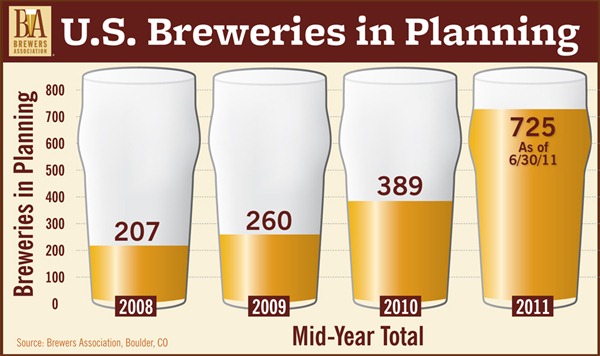
US craft beer continues to grow
It may seem a strange thing, but even an act as simple as being able to define the size of the craft beer market can play a role in seeing that market grow. As media interest in this segment of the market grows, one of the first things journalists often ask about beer is, “how quickly is craft beer growing”. With most beer industry statistics proprietary and offering a fairly inaccurate snapshot of the market this question is generally always answered in a fairly general way. The media love snappy answers and information that tells a story, the craft brewers in Australia can’t do that. Hopefully if the mooted Australian craft brewers association proceeds, it will be able to rectify that.
US Brewers Association Media Release
The Brewers Association, the trade association representing the majority of U.S. brewing companies, has released strong mid-year numbers for America’s small and independent craft brewers¹. Dollar sales were up 15 per cent in the first half of 2011, excluding brewers who left the craft segment in 2010². Volume of craft brewed beer sold grew 14 per cent for the first six months in 2011, compared to 9 per cent growth in the first half of 2010.
Barrels sold by craft brewers for the first half of the year are an estimated 5.1 million barrels. Despite many challenges, the mid-year numbers show signs of continued growth for craft breweries. The industry currently provides an estimated 100,000 jobs, contributing significantly to the U.S. economy.
“Craft brewers continue to innovate and brew beers of excellent quality,” noted Paul Gatza, director of the Brewers Association.
“America’s beer drinkers are rapidly switching to craft because of the variety of flavours they are discovering. And they are connecting with small and independent craft brewers as companies they choose to support.”
The U.S. now boasts 1,790 breweries—an increase of 165 additional breweries since June 2010. The Brewers Association also tracks breweries in planning as an indicator of potential new entrants into the craft category, and lists 725 breweries in planning today compared to 389 a year ago. Additionally, the count of craft brewers was at 1,740 as of June 30, 2011.
“There is a growing interest in establishing new breweries,” Gatza added. “It seems like every day we are hearing about a brewery in planning. Will they all make it? No, but many will if they produce high-quality, interesting craft beers and can get them to market through self-distribution and beer wholesalers and beer retailers.”
(1) The definition of a craft brewer as stated by the Brewers Association: An American craft brewer is small, independent, and traditional. Small: Annual production of beer less than 6 million barrels. Beer production is attributed to a brewer according to the rules of alternating proprietorships. Flavoured malt beverages are not considered beer for purposes of this definition. Independent: Less than 25% of the craft brewery is owned or controlled (or equivalent economic interest) by an alcoholic beverage industry member who is not themselves a craft brewer. Traditional: A brewer who has either an all malt flagship (the beer which represents the greatest volume among that brewers brands) or has at least 50% of its volume in either all malt beers or in beers which use adjuncts to enhance rather than lighten flavour.
(2) Three former craft brewing companies left the segment in the second half of 2010 when transitions led them to no longer meet the Brewers Association’s definition of independence.
[adrotate group=”1″]




